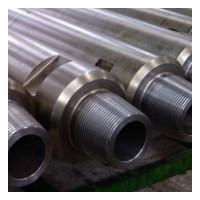| Sign In | Join Free | My himfr.com |
|
| Sign In | Join Free | My himfr.com |
|
| Ask Lasest Price | |
| Brand Name : | DINGSCO |
| Model Number : | According to customers' requests |
| Certification : | ISO 9001: 2015, API 7-1 |
| Price : | Negotiable |
| Payment Terms : | T/T |
| Supply Ability : | Negotiable |
| Delivery Time : | (Sample order) 7 days |
Non-Magnetic Alloy Drill Collar Heavy Weight Drill Pipe HWDP for Oil Tools Equipment
A non-magnetic drill collar is an essential component in the oil and gas industry, particularly used in directional drilling. These drill collars are designed to be non-magnetic to minimize interference with the measurement-while-drilling (MWD) and logging-while-drilling (LWD) tools, which rely on accurate magnetic measurements to determine the orientation and position of the drill bit.
Key Characteristics of Non-Magnetic Drill Collars:
Material:
Typically made from non-magnetic stainless steels or other
non-magnetic alloys. Common materials include beryllium copper or
high-strength non-magnetic steels such as AISI 4145H modified alloy
steel.
Non-Magnetic Properties:
To ensure that the surrounding magnetic field is not distorted,
these collars exhibit extremely low magnetic permeability.
Dimensions:
Diameters and lengths may vary to match the specific requirements
of the drilling operation. Common sizes vary from 3 inches to 11
inches in outer diameter.
Mechanical Properties:
High toughness and durability to withstand the mechanical stresses
encountered during drilling operations. Non-magnetic drill collars
must maintain their strength and non-magnetic properties over a
wide range of temperatures and corrosive environments.
Design:
They typically feature a uniform diameter throughout their length,
with threaded connections on both ends to connect with other drill
string components.
Some designs may include spiral grooves to reduce differential
sticking and improve the flow of drilling fluids.
Application:
Non-magnetic drill collars are employed directly above the drill
bit and below the MWD and LWD tools in the drill string to ensure
that the magnetic measurements required for logging and steering
are not affected by the drill string's ferromagnetic components.
Benefits:
Improved Directional Control: Minimizes magnetic interference, enhancing the accuracy of
directional drilling.
Safety: Reduces the risk of drill string sticking and other issues
associated with magnetic interference.
Durability: High mechanical strength ensures longevity and reliability in
harsh drilling environments.
Technical Parameters (or customized)
| SPEC.(MM) | OD.(MM) | Magnetic Permeability | Tensile Strength (Mpa) | Yield Strength (Mpa) |
| Φ63 | 63 | ≤1.005 | ≥1035 | ≥965 |
| Φ73 | 73 | ≤1.005 | ≥1035 | ≥965 |
| Φ76 | 76 | ≤1.005 | ≥1035 | ≥965 |
| Φ89 | 89 | ≤1.005 | ≥1035 | ≥965 |
| Φ91 | 91 | ≤1.005 | ≥1035 | ≥965 |

|




